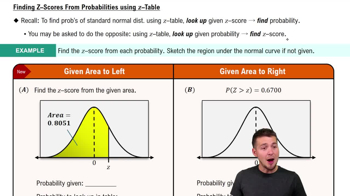In Exercises 21–26, find the indicated probability using the standard normal distribution. If convenient, use technology to find the probability.
P(0.42 < z < 3.15)
 Verified step by step guidance
Verified step by step guidance Verified video answer for a similar problem:
Verified video answer for a similar problem:



 9:47m
9:47mMaster Finding Standard Normal Probabilities using z-Table with a bite sized video explanation from Patrick
Start learning